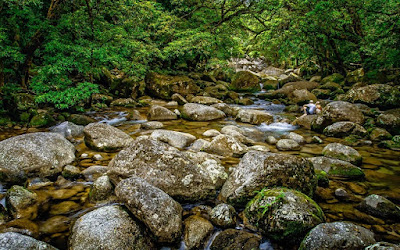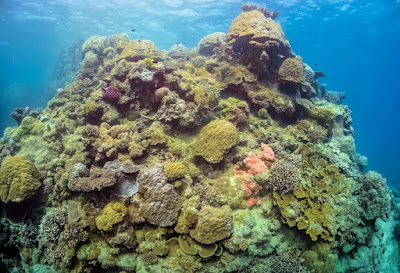From Little Wanganui, we headed north to the Department of Conservation
(DOC) office in Karamea to get a map of Kahurangi, New Zealand’s second largest
national park. We wanted to day-hike the lower end of the Heaphy Track along
the Tasman Sea. The Heaphy is one of New Zealand’s Great Walks (4-5 days from
Karamea to Golden Bay, north of Abel Tasman National Park). According to a sign
at the trailhead, Charles Heaphy, a European explorer, was guided down the West
Coast by Kehu, his Māori guide, in 1846. We stayed at Kohaihai, a DOC campground
at the northern end of the Karamea- Kohaihai Road. It was small and undeveloped,
but had toilets and potable water and cost $6 NZD per night. The campground was
mostly empty and our spot had a view of the Tasman Sea out the back windows. The
sandy beach behind us was steep, not very wide, and littered with weathered tree
trunks.
Wednesday, October 4, 2017
Friday, August 25, 2017
Little Wanganui and the Whitebait
The drive north from Westport along the Tasman Sea was
spectacular. Forest-covered mountains spill down to a narrow coastal plain of
pasturelands. The forested hills are filled with fern trees; everything is
green and wet. Lots of mud; people wear rubber boots here. The road left the
coast and climbed a small mountain; another narrow, twisty, wet road that I had
to drive with both hands on the wheel. On some of the curves and bridges, we
had less than 0.6 m (2 ft) on either side of the caravan. Amazingly, 20-wheel
commercial trucks with double trailers navigate the one-lane bridges and
one-lane blind curves (with stop lights no less!) carved out of the mountainside.
Labels:
caravanning,
common galaxias,
fish,
fish trap,
fishing,
fishing technique,
Galaxiidae,
inanga,
life history,
Little Wanganui River,
Māori,
New Zealand,
Okuru River,
South Island,
whitebait
Saturday, August 12, 2017
N Zed – The Beginning
Our plan was to spend five weeks circumnavigating the South
Island of New Zealand in a campervan (known as a caravan in Australia and New
Zealand). We’ve always gone camping, backpacking in our younger days and, more
recently, out of the back of a four-wheel drive pickup on federal lands around
the western U.S. New Zealand would be our first long trip in an RV as a test,
not of our marriage, but of whether we’d like to own one ourselves. We arrived
in Christchurch at midnight. Immigration was automated: scan your passport,
answer a couple of questions, drop your incoming visitor card in a box welcome
to New Zealand. Customs officers asked us questions about food and x-rayed our
bags. A female officer asked if her beagle could sniff us and our luggage for
fresh fruit; the dog tried to climb into Rande’s purse. She had an empty
plastic bag that had carried apples and bananas, which we had eaten before we
arrived. Outside the terminal, we caught the shuttle to the Sudima, a large,
upscale hotel near the airport and fell into bed.
Labels:
Abel Tasman National Park,
birds,
Buller River,
caravan,
caravanning,
driving,
hiking,
Kaikoura,
kiwi,
lowland forest,
Marahau,
Marlborough,
New Zealand,
Pelorus Bridge,
Pelorus Sound,
South Island,
wildlife
Tuesday, July 18, 2017
Port Douglas – Part 2
A couple days after catching a
cold, I felt good enough to go for a hike, so we drove up to Mossman Gorge (link, link) in the southern section of the Daintree National Park, another “must-see”
attraction north of Port Douglas. The Mossman River spills down the Main Coast
Range of mountains winding its way through weathered granite boulders the size
of small cars. It’s hard to comprehend the amount of energy it took to move these
massive boulders down the mountains, and the time it took for the water
to wear them smooth.
Labels:
Australia,
coral bleaching,
coral reef,
cuttlefish,
Daintree National Park,
diving,
fish,
Great Barrier Reef,
hiking,
intertidal,
invertebrates,
Mossman Gorge,
Port Douglas,
Queensland,
tropical forest
Thursday, June 15, 2017
Port Douglas - Part 1
The two-lane road north from
Cairns to Port Douglas winds 50 km (31 mi) up the coast past sugar cane fields and beach resorts, and through small towns and tropical rainforest. We passed a large group of wallabies (known as a mob) grazing in a large pasture along the road. I parked next to a lawn bowling complex and, camera
in hand, walked around the corner of the building and began taking pictures. A man
came out of the building and told us to come inside, but to stay
behind the fence because "wallabies can be aggressive if you get too close." Inside the open-air facility, twenty people were bowling in a tournament. One of the
women bowlers said that a few weeks earlier, a man taking photographs in the pasture was attacked by a male wallaby.
Labels:
Australia,
cassowary,
coral reef,
Daintree National Park,
diving,
estuary,
fish,
Great Barrier Reef,
hiking,
invertebrates,
mangrove,
Queensland,
rainforest,
sea fan,
wallaby,
World Heritage Site
Wednesday, March 1, 2017
Eungella to Cairns: the Coral Sea
We rented an apartment in Yorkeys
Knob, a small community on the beach about 20 km north of Cairns. It was named
for George “Yorkey” Lawson, a fisherman from Yorkshire, England who homesteaded
there. We looked in Cairns, a city of 150,000 on the east
coast of the Cape York Peninsula, but chose a more relaxed town on the beach
north of the city. Cairns spreads out along a mud flat south of the Barron
River. The downtown was crowded with traffic and tourists, and we had to pay to
park everywhere. In the morning, a constant stream of buses dropped off
hundreds of tourists at the marina where they boarded day-boats going to the Great
Barrier Reef. Tourists that didn’t go to the reef wandered the Esplanade eating
in the restaurants and visiting gift shops and boutiques. I stopped at
three dive shops for information on trips to the Great Barrier Reef, and two underwater
camera shops to get parts for my camera. Unlike Airlie Beach, dive shops and
dive-boat operators are thriving in Cairns. I made a reservation for a day trip on the
Tusa 6, which was recommended by one
of the dive shops.
Labels:
Australia,
Cairns,
climate change,
coral bleaching,
coral reef,
crown-of-thorns starfish,
diving,
fish,
Great Barrier Reef,
Hastings Reef,
invertebrates,
Michaelmas Cay,
Queensland
Monday, February 13, 2017
Eungella to Cairns: the Eastern Highlands
Consider the platypus. It has a duck-like bill covered with specialized
receptors for finding its prey; a beaver-like tail covered with fur that is not
used for swimming; and otter-like webbed feet for swimming (front) and steering
(rear) armed with straight claws for digging (front) and curved claws for grooming
(rear). Females lay eggs and nurse their young, but lack nipples. If you didn’t
already know that it exists, you’d be hard pressed to believe that it does. Platypus
were “discovered” near Sydney by European settlers in 1797 (of course, Aboriginal
Australians knew about them for millennia). Bewildered, the local governor sent
skins and drawings to Great Britain. British zoologists who examined the
specimens in 1798 thought they were a hoax perpetrated by Chinese taxidermists,
who were selling mummified monkeys with fish tails as mermaids at the time (link).
 |
| Platypus in Broken River, Eungella National Park |
Subscribe to:
Posts (Atom)





